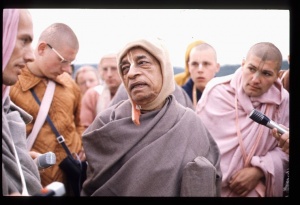SB 3.26.15

A.C. Bhaktivedanta Swami Prabhupada
TEXT 15
- etāvān eva saṅkhyāto
- brahmaṇaḥ sa-guṇasya ha
- sanniveśo mayā prokto
- yaḥ kālaḥ pañca-viṁśakaḥ
SYNONYMS
etāvān — so much; eva — just; saṅkhyātaḥ — enumerated; brahmaṇaḥ — of Brahman; sa-guṇasya — with material qualities; ha — indeed; sanniveśaḥ — arrangement; mayā — by Me; proktaḥ — spoken; yaḥ — which; kālaḥ — time; pañca-viṁśakaḥ — the twenty-fifth.
TRANSLATION
All these are considered the qualified Brahman. The mixing element, which is known as time, is counted as the twenty-fifth element.
PURPORT
According to the Vedic version there is no existence beyond Brahman. Sarvaṁ khalv idaṁ brahma (Chāndogya Upaniṣad 3.14.1). It is stated also in the Viṣṇu Purāṇa that whatever we see is parasya brahmaṇaḥ śaktiḥ; everything is an expansion of the energy of the Supreme Absolute Truth, Brahman. When Brahman is mixed with the three qualities goodness, passion and ignorance, there results the material expansion, which is sometimes called saguṇa Brahman and which consists of these twenty-five elements. In the nirguṇa Brahman, where there is no material contamination, or in the spiritual world, the three modes—goodness, passion and ignorance—are not present. Where nirguṇa Brahman is found, simple unalloyed goodness prevails. Saguṇa Brahman is described by the Sāṅkhya system of philosophy as consisting of twenty-five elements, including the time factor (past, present and future).